Lighting
Obviously the ideal situation is to have lots of natural light in a kitchen, whether it comes from windows or a skylight. The more natural light, the better, although you don't want to be standing at the kitchen sink at dinnertime with the sun baking you. Natural light makes it more pleasant to be and work in the kitchen, not to mention it reduced your energy bill. Regardless of how much natural light you have, you will need to think about what your needs are on a cloudy day or at night. And in addition to that, local building codes have specific requirements for lighting in a kitchen that you need to be aware of.
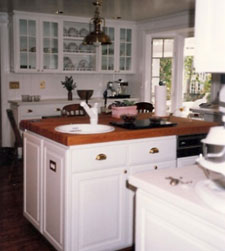
Lighting function: The most basic need in any room of the house, including the kitchen, is general illumination. That typically consists of a surface mounted ceiling fixture located in the center of the room that gives adequate lighting to move through the room safely without tripping over something. In a kitchen that would cover being able to put the groceries away, get into the refrigerator or unload the dishwasher. With the addition of the light in an overhead ventilation hood you might also be able to do some basic cooking. And if there is a light over the kitchen sink you could probably function fully, including preparing food and serving it. While kitchens of the past survived with only a center fixture, the lighting on the countertop surfaces wasn't ideal due to shadows created by the person standing in front of them. That's why task lighting is necessary.
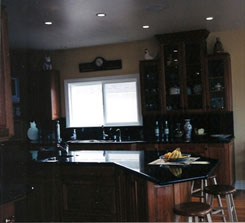
Task lighting can be recessed can fixtures over the counters, under-cabinet lighting or lighting anywhere you will be preparing or cooking. This is in addition to turning on the general lighting to walk through the room. And it would have separate switches so that you could choose the level of lighting that you are going to require.
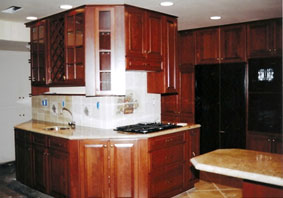
I prefer to place the recessed lighting over the countertops in front of the wall cabinets so that it will not hit you on the top of your head and
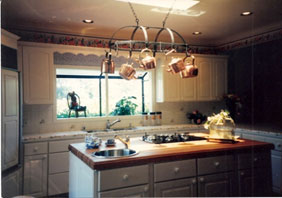
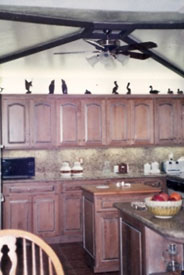
Under cabinet lighting is installed on the bottom of the wall cabinets on a separate switch or it can be switched on the fixture itself. I find that under-cabinet lighting is often used as an accent light and left on in the evening while the family is watching TV. It's more attractive than general lighting and an alternative if you want to create a different kind of mood.
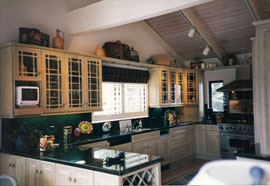
Track lighting isnít used so much anymore because most houses are two stories and have 8-foot ceilings. But if you have a vaulted ceiling in your kitchen, track lighting may be the best option. If you haven't looked lately, there are some very attractive bullets available, both contemporary and traditional, that look nothing like the styles that you might remember.
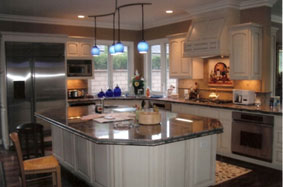
And then there's also decorative lighting, which is typically used over a seating area, bar, island or table-and sometimes even over the kitchen sink area. Pendants have become popular recently and they add another element of style that a recessed fixture does not.
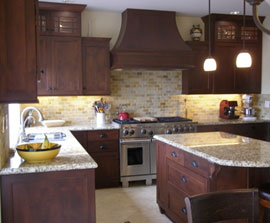
Cabinet lighting is often used when there is a wall cabinet with glass doors that is decorative and you would like to illuminate. Chances are you will be dealing with low-voltage lights that either have a transformer in the fixture or will have a separate transformer that will have to be located somewhere between the power source and the fixture itself. That means not in the glass door cabinet where you can see it. These fixtures are typically 3/4" thick and are recessed into the top of the glass door cabinet. We call them "puck" lights because they resemble a hockey puck. They are available in LED or in halogen. Be sure you account for their wattage when you are doing your calculations.
Types of illumination: In the old days there was incandescent. Period. You might not be aware of it, but incandescent light fixtures are more effective at putting out heat than they are putting out light. In other words, they are inefficient. And since we are all into being energy efficient these days, incandescent light bulbs are being phased out - especially in a kitchen where it seems like they put off as much heat as the oven. We all know what incandescent lights bulbs look like. There are a variety of sizes and shapes, including floods and spots for your recessed ceiling fixtures or candlelabras for your accent lighting. Not that long ago we began using halogen fixtures in recessed can fixtures because the quality of the light was superior. But they are also energy inefficient and put out a lot of heat.
Fluorescent fixtures have been around for a long time, but have never been the favorite of many people who associate them with garage been the favorite of many people who associate them with garage fixtures or the flickering, humming ballasts that drive us crazy. However, they are energy efficient, so they have been updated with an electronic ballast to eliminate the humming and flickering that so many people object to. In addition, they are available in several "colors", depending on your personal taste (from warm to cool light frequencies). There for a while we would satisfy the building departments by putting fluorescent under-cabinet lighting in so that the can lights could be incandescent. Now you can get compact fluorescent bulbs for the can fixtures as well. And they can be used in decorative or accent lighting too.
LED (light emitting diode) lighting has been around for a while, but the choices are limited in terms of wattage and application. As with all new innovations, they are expensive when they first come out. After a while, the price will come down and there will be a better selection. Which is great, because they are my all-time favorite. They are quite a bit more energy efficient than even fluorescents are. They may be expensive, but they may also be the last light bulb that you buy for the fixture. And your energy bill will go down. You may have noticed them in the new refrigeration cases at the grocery stores. They are used there because they don't create heat, like the older lamps did. And since building codes require high-efficacy lighting, that means either fluorescent or LED, take your pick.
Energy requirements: Building codes will vary, depending on which part of the country you reside in and which code your building department adheres to. But they are all requiring more efficient lighting. And since it is so much easier to replace or add lighting in the kitchen when you are remodeling, this is something you need to consider in your budget. In California, which has the highest standards for energy efficiency of any state, 50% of the wattage in the kitchen must be high efficacy (fluorescent or LED). That's not 50% of the fixtures, that's 50% of the overall lwattage. Putting fluorescent fixtures under the wall cabinets does not offset all the recessed can lights in the ceiling in terms of wattage. So be prepared to put fluorescent lamps in the can lights. Then you can use incandescent or halogen in the pendants over the sink and island. Your contractor will actually have to calculate, based on the lighting plan that your designer has come up with, how many fixtures will have to be high efficacy.
Switching and dimmers: If there's only one way in and out of your kitchen, then you will most likely have one switch for turning the lights on and off at a convenient location as you enter the room. However, if you can enter the kitchen from both the dining room and the family room, then it would make sense to have a3-way switch which gives you two switches - one when you enter from the dining room and one when you enter from the family room. If you have an open concept kitchen or you can also enter the kitchen from a garage or an outside door, then you might want a 4-way switch, which really means that you can turn the lights on from 3 different locations. You don't want to have to walk through the room in order to turn on a light.
And you may not have just one switch for one light. Chances are you will have a switch (or two)for your recessed fixtures, a switch for the lights over the island and a switch for the lighting over the sink. And, depending on how large your kitchen is, there may be additional requirements. Obviously the kitchen sink light doesn't need to be switched from anywhere except at the sink area unless the entire wall is windows. Then you will have to find another location for the switch. You and your designer or contractor will have to discuss in advance how you would like your lighting to function and how flexible you need it to be. You will want to visualize how you are going to enter and leave your new kitchen (as the layout may be changing) and where you will want to be able to turn the lights on and off.
In order to install a box inside the wall for switches, you have to have wall space that is in-between wall studs. Your contractor will be able to help you determine where your potential locations are. You can't really even do a lighting plan until your kitchen is designed, but once you have it, it is a good idea to order your light fixtures when you order the cabinets so that all of these decisions can be made simultaneously. The rough electric needs to be completed while the walls are open, so you can't wait until the cabinets are installed to decide where you are going to put your lights.
# # #
